A Functional Single Nucleotide Polymorphism in the 3′ Untranslated Region of the Porcine JARID2 Gene Is Associated with Aggressive Behavior of Weaned Pigs after Mixing
Abstract
:1. Introduction
2. Results
2.1. Association Analysis of SNPs of the JARID2 Gene with Aggressive Behavior of Pigs after Mixing
2.2. Expression Profile of Porcine JARID2 Gene and miR-9828-3p in Different Tissues
2.3. Isolation, Culture, and Identification of Porcine Neural Cells
2.4. MiR-9828-3p Targets the 3′-UTR of JARID2 mRNA
2.5. Inhibition of miR-9828-3p Rescues Knocked-Down JARID2 Gene Expression
2.6. MiR-9828-3p Inhibits Proliferation of Porcine Neuroglial Cells
3. Discussion
4. Materials and Methods
4.1. Animals and Sample Collection
4.2. Behavioral Observation and Statistics
4.3. Single-Nucleotide Polymorphism Typing and Behavioral Association Analysis
4.4. Prediction of miRNAs in the 3′-UTR Region of the JARID2 Gene and Plasmid Construction
4.5. Cell Culture, Cell Transfection, and Luciferase Assays
4.6. Culture of PK15 Cells, Isolation and Immunostaining Identification of Porcine Neural Cells
4.7. Total RNA Extraction, Inversion, and qRT-PCR
4.8. Western Blotting
4.9. EdU Detects the Proliferation of Porcine Neuroglial Cells
4.10. Statistical Analysis
Author Contributions
Funding
Institutional Review Board Statement
Informed Consent Statement
Data Availability Statement
Conflicts of Interest
Appendix A
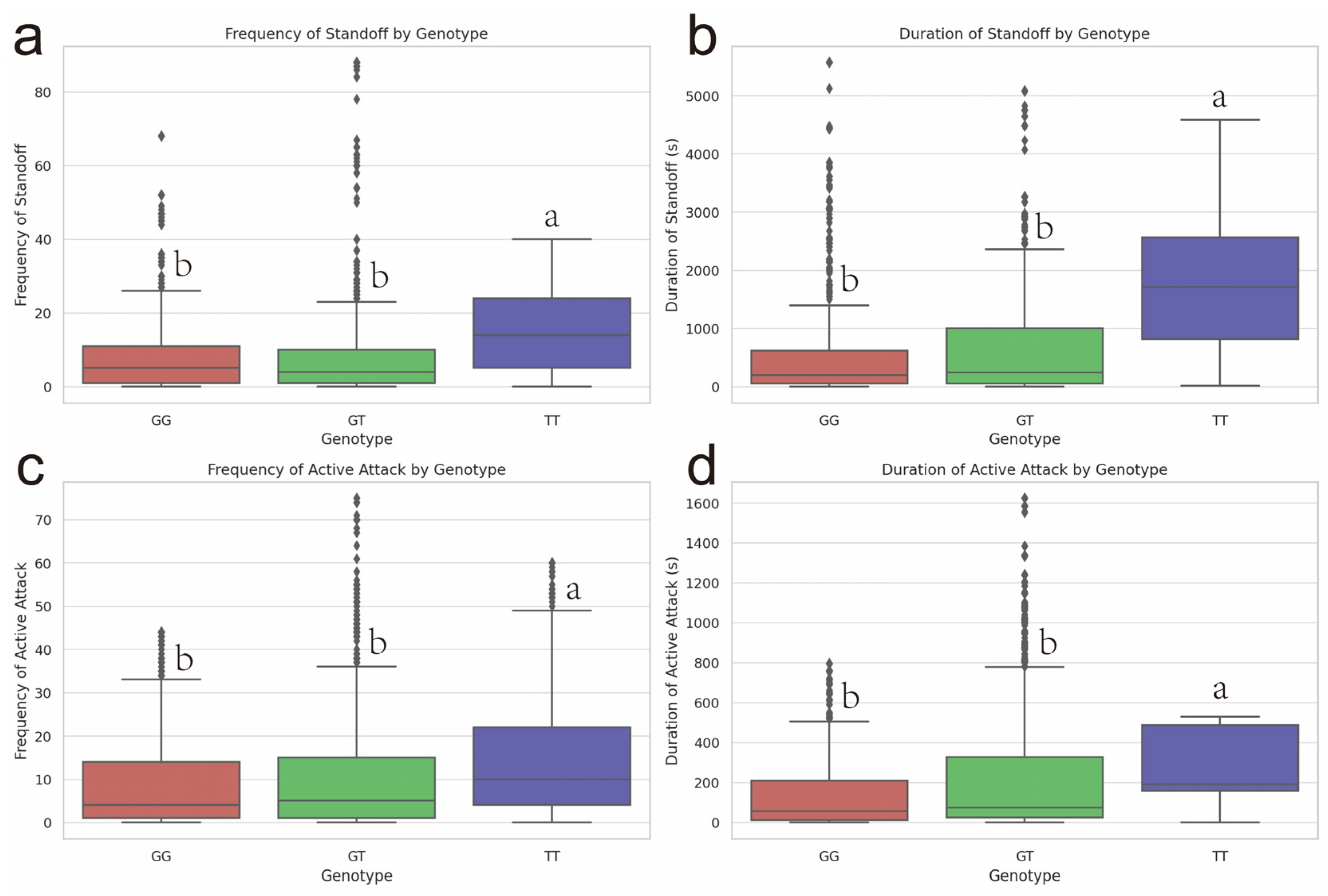
| Behavior | Description |
|---|---|
| Fight | A vigorous biting, head-knocking, or displacement with the physical contact of two individuals for more than 3 s and intervening periods of less than 8 s; otherwise, the fight was interrupted. In a fight, a pig shows active attack, then the other pig shows being bullied, or both show standoff behavior. |
| Active attack | In a fight, a pig actively gives a biting, pushing, or chasing to another pig. |
| Standoff | In a fight, if the two pigs stand side by side, shoulder to shoulder, and one pig throws his head to the head or neck of the other pig, there is an aggressive interaction with no dominance sign produced by either pair member at any time. |
| Primer | Primer Sequence (5′-3′) | Product Size (bp) | Start | Stop | Usage |
|---|---|---|---|---|---|
| JARID2-3′UTR-P1 | F:CGGGCGAGGGATGGATATTTA | 565 | 15 | 35 | 3′UTR-PCR |
| R:AAACACAACGGGGAGTCTCC | 579 | 599 | |||
| JARID2-3′UTR-P2 | F:TTTCTTTGGGCGGTG ATGGC | 503 | 577 | 596 | 3′UTR-PCR |
| R:ATAGACCAGATGAGCGCAGA | 1080 | 1100 | |||
| JARID2 WT and MUT | F:CGAGCTCGGTTGAAACCGGAGACTCCCC | 202 | miR-9828-3p vector construction | ||
| R:GCTCGATAGCCACAGGTTTCCCTCACGTGA | |||||
| JARID2 | F:GCTCAATCCCAGCCGAATAG | 338 | RT-qPCR | ||
| R:GCTGGAACCATTGAAAACAT | |||||
| GAPDH | F:CAAGGAGTAAGAGCCCCTGG | 181 | RT-qPCR | ||
| F:GGTACATGACGAGGCAGGTC | |||||
| miR-9828-3p | F: GGUUUCAGGCCGGUCGCUCGA | RT-qPCR | |||
| R:CAGCCACAAAAGAGCACAAT | |||||
| U6 | F:GCTTCGGCAGCACATATAC | 86 | RT-qPCR | ||
| R:TTCACGAATTTGCGTGTCAT | |||||
| PCNA | F:TGCAGATGTACCCCTTGTTGT | 164 | RT-qPCR | ||
| R:TATGTGCTGGCATCACCGAA | |||||
| CCND1 | F:ATCAGGTGTGACCCGGACT | 184 | RT-qPCR | ||
| R:CGCCTCAAATGTTCACGTCG |
| Sequence Name | Sense (5′-3′) | Antisense (5′-3′) |
|---|---|---|
| Si-JARID2-2 | GCGGCAAAGUGGACACCAACA | UUGGUGUCCACUUUGCCGCAG |
| Si-NC | UUCUCCGAACGUGUCACGUTT | ACGUGACACGUUCGGAGAATT |
| miR-9828-3p mimics | GGUUUCAGGCCGGUCGCUCGA | TCGAGCGACCGGCCTGAAACC |
| mimics NC | UUCUCCGAACGUGUCACGUTT | ACGUGACACGUUCGGAGAATT |
| miR-9828-3p inhibitor | UCGAGCGACCGGCCUGAAACC | GGTTTACAGGCCGGTCGCTCGA |
| inhibitor NC | CAGUACUUUUGUGUAGUACAA | TTGTACTACACAAAAGTACTG |
References
- Camerlink, I.; Ursinus, W.W.; Bijma, P.; Kemp, B.; Bolhuis, J.E. Indirect Genetic Effects for Growth Rate in Domestic Pigs Alter Aggressive and Manipulative Biting Behaviour. Behav. Genet. 2014, 45, 117–126. [Google Scholar] [CrossRef] [PubMed]
- Lee, J.; Jin, L.; Park, D.; Chung, Y. Automatic Recognition of Aggressive Behavior in Pigs Using a Kinect Depth Sensor. Sensors 2016, 16, 631. [Google Scholar] [CrossRef] [PubMed]
- Ji, H.; Teng, G.; Yu, J.; Wen, Y.; Deng, H.; Zhuang, Y. Efficient Aggressive Behavior Recognition of Pigs Based on Temporal Shift Module. Animals 2023, 13, 2078. [Google Scholar] [CrossRef] [PubMed]
- Hellbrügge, B.; Tölle, K.H.; Bennewitz, J.; Henze, C.; Presuhn, U.; Krieter, J. Genetic aspects regarding piglet losses and the maternal behaviour of sows. Part 1. Genetic analysis of piglet mortality and fertility traits in pigs. Animal 2008, 2, 1273–1280. [Google Scholar] [CrossRef]
- Scheffler, K.; Stamer, E.; Traulsen, I.; Krieter, J. Estimation of genetic parameters for agonistic behaviour of pigs at different ages. J. Agric. Sci. 2016, 154, 732–741. [Google Scholar] [CrossRef]
- Canario, L.; Bijma, P.; David, I.; Camerlink, I.; Martin, A.; Rauw, W.M.; Flatres-Grall, L.; Zande, L.V.D.; Turner, S.P.; Larzul, C.; et al. Prospects for the Analysis and Reduction of Damaging Behaviour in Group-Housed Livestock, with Application to Pig Breeding. Front. Genet. 2020, 11, 611073. [Google Scholar] [CrossRef] [PubMed]
- Takeuchi, T.; Yamazaki, Y.; Katoh-Fukui, Y.; Tsuchiya, R.; Kondo, S.; Motoyama, J.; Higashinakagawa, T. Gene trap capture of a novel mouse gene, jumonji, required for neural tube formation. Genes Dev. 1995, 9, 1211–1222. [Google Scholar] [CrossRef]
- Kusunoki, H.; Takeuchi, T.; Kohno, T. Solution structure of the AT-rich interaction domain of Jumonji/JARID2. Proteins Struct. Funct. Bioinform. 2009, 76, 1023–1028. [Google Scholar] [CrossRef]
- Adhikari, A.; Mainali, P.; Davie, J.K. JARID2 and the PRC2 complex regulate the cell cycle in skeletal muscle. J. Biol. Chem. 2019, 294, 19451–19464. [Google Scholar] [CrossRef]
- Zhang, J.; Roberts, J.M.; Chang, F.; Schwakopf, J.; Vetter, M.L. Jarid2 promotes temporal progression of retinal progenitors via repression of Foxp1. Cell Rep. 2023, 42, 112237. [Google Scholar] [CrossRef]
- Bergé-Lefranc, J.L.; Jay, P.; Massacrier, A.; Cau, P.; Mattei, M.G.; Bauer, S.; Marsollier, C.; Berta, P.; Fontes, M. Characterization of the human jumonji gene. Hum. Mol. Genet. 1996, 5, 1637–1641. [Google Scholar] [CrossRef] [PubMed]
- Takeuchi, T. A gene trap approach to identify genes that control development. Dev. Growth Differ. 1997, 39, 127–134. [Google Scholar] [CrossRef] [PubMed]
- Loh, C.H.; van Genesen, S.; Perino, M.; Bark, M.R.; Veenstra, G.J.C. Loss of PRC2 subunits primes lineage choice during exit of pluripotency. Nat. Commun. 2021, 12, 6985. [Google Scholar] [CrossRef] [PubMed]
- Pedrosa, E.; Ye, K.; Nolan, K.A.; Morrell, L.; Okun, J.M.; Persky, A.D.; Saito, T.; Lachman, H.M. Positive association of schizophrenia toJARID2 gene. Am. J. Med. Genet. Part B Neuropsychiatr. Genet. 2007, 144, 45–51. [Google Scholar] [CrossRef] [PubMed]
- Liu, X.; Shimada, T.; Otowa, T.; Wu, Y.-Y.; Kawamura, Y.; Tochigi, M.; Iwata, Y.; Umekage, T.; Toyota, T.; Maekawa, M.; et al. Genome-wide Association Study of Autism Spectrum Disorder in the East Asian Populations. Autism Res. 2016, 9, 340–349. [Google Scholar] [CrossRef] [PubMed]
- Afonso-Grunz, F.; Müller, S. Principles of miRNA–mRNA interactions: Beyond sequence complementarity. Cell. Mol. Life Sci. 2015, 72, 3127–3141. [Google Scholar] [CrossRef] [PubMed]
- Jiang, Y.; Liu, Y.; Sun, Y.; Liu, Y.; Feng, L.; Duan, M.; Liu, Y.; Xu, L. Sevoflurane induces microRNA-18a to delay rat neurodevelopment via suppression of the RUNX1/Wnt/β-catenin axis. Cell Death Discov. 2022, 8, 404. [Google Scholar] [CrossRef]
- Thomas, K.T.; Zakharenko, S.S. MicroRNAs in the Onset of Schizophrenia. Cells 2021, 10, 2679. [Google Scholar] [CrossRef]
- Serafini, G.; Pompili, M.; Hansen, K.F.; Obrietan, K.; Dwivedi, Y.; Shomron, N.; Girardi, P. The Involvement of MicroRNAs in Major Depression, Suicidal Behavior, and Related Disorders: A Focus on miR-185 and miR-491-3p. Cell. Mol. Neurobiol. 2013, 34, 17–30. [Google Scholar] [CrossRef]
- Barøy, T.; Misceo, D.; Strømme, P.; Stray-Pedersen, A.; Holmgren, A.; Rødningen, O.K.; Blomhoff, A.; Helle, J.R.; Stormyr, A.; Tvedt, B.; et al. Haploinsufficiency of two histone modifier genes on 6p22.3, ATXN1 and JARID2, is associated with intellectual disability. Orphanet. J. Rare Dis. 2013, 7, 3. [Google Scholar] [CrossRef]
- Verberne, E.A.; van der Laan, L.; Haghshenas, S.; Rooney, K.; Levy, M.A.; Alders, M.; Maas, S.M.; Jansen, S.; Lieden, A.; Anderlid, B.-M.; et al. DNA Methylation Signature for JARID2-Neurodevelopmental Syndrome. Int. J. Mol. Sci. 2022, 23, 8001. [Google Scholar] [CrossRef] [PubMed]
- Hodgins, S. Aggressive Behavior Among Persons with Schizophrenia and Those Who Are Developing Schizophrenia: Attempting to Understand the Limited Evidence on Causality. Schizophr. Bull. 2017, 43, 1021–1026. [Google Scholar] [CrossRef] [PubMed]
- Chen, X.; Long, F.; Cai, B.; Chen, X.H.; Chen, G. A Novel Relationship for Schizophrenia, Bipolar and Major Depressive Disorder Part 6: A Hint from Chromosome 6 High Density Association Screen. Curr. Mol. Med. 2016, 16, 840–854. [Google Scholar] [CrossRef] [PubMed]
- Liu, Y.; Chen, G.; Norton, N.; Liu, W.; Zhu, H.; Zhou, P.; Luan, M.; Yang, S.; Chen, X.; Carroll, L.; et al. Whole Genome Association Study in a Homogenous Population in Shandong Peninsula of China Reveals JARID2 as a Susceptibility Gene for Schizophrenia. J. Biomed. Biotechnol. 2009, 2009, 536918. [Google Scholar] [CrossRef] [PubMed]
- Ramos, P.S.; Sajuthi, S.; Langefeld, C.D.; Walker, S.J. Immune function genes CD99L2, JARID2 and TPO show association with autism spectrum disorder. Mol. Autism 2012, 3, 4. [Google Scholar] [CrossRef]
- Takeuchi, T.; Watanabe, Y.; Takano-Shimizu, T.; Kondo, S. Roles of jumonji and jumonji family genes in chromatin regulation and development. Dev. Dyn. 2006, 235, 2449–2459. [Google Scholar] [CrossRef]
- Ghosh, S.; Ataman, M.; Bak, M.; Börsch, A.; Schmidt, A.; Buczak, K.; Martin, G.; Dimitriades, B.; Herrmann, C.J.; Kanitz, A.; et al. CFIm-mediated alternative polyadenylation remodels cellular signaling and miRNA biogenesis. Nucleic Acids Res. 2022, 50, 3096–3114. [Google Scholar] [CrossRef]
- Jensen, K.P.; Covault, J.; Conner, T.S.; Tennen, H.; Kranzler, H.R.; Furneaux, H.M. A common polymorphism in serotonin receptor 1B mRNA moderates regulation by miR-96 and associates with aggressive human behaviors. Mol. Psychiatry 2008, 14, 381–389. [Google Scholar] [CrossRef]
- Yang, Y.; Lu, W.; Ning, M.; Zhou, X.; Wan, X.; Mi, Q.; Yang, X.; Zhang, D.; Zhang, Y.; Jiang, B.; et al. A functional SNP rs895819 on pre-miR-27a is associated with bipolar disorder by targeting NCAM1. Commun. Biol. 2022, 5, 309. [Google Scholar] [CrossRef]
- Viitasalo, L.; Kettunen, K.; Kankainen, M.; Niemelä, E.H.; Kiiski, K. A novel partial de novo duplication of JARID2 gene causing a neurodevelopmental phenotype. Mol. Genet. Genom. Med. 2022, 10, e2037. [Google Scholar] [CrossRef]
- Wen, Z.; He, K.; Zhan, M.; Li, Y.; Liu, F.; He, X.; Wei, Y.; Zhao, W.; Zhang, Y.; Xue, Y.; et al. Distinct binding pattern of EZH2 and JARID2 on RNAs and DNAs in hepatocellular carcinoma development. Front. Oncol. 2022, 12, 904633. [Google Scholar] [CrossRef] [PubMed]
- Iseki, H.; Nakachi, Y.; Hishida, T.; Yamashita-Sugahara, Y.; Hirasaki, M.; Ueda, A.; Tanimoto, Y.; Iijima, S.; Sugiyama, F.; Yagami, K.-I.; et al. Combined Overexpression of JARID2, PRDM14, ESRRB, and SALL4A Dramatically Improves Efficiency and Kinetics of Reprogramming to Induced Pluripotent Stem Cells. Stem Cells 2016, 34, 322–333. [Google Scholar] [CrossRef] [PubMed]
- Lei, X.; Xu, J.-F.; Chang, R.-M.; Fang, F.; Zuo, C.H.; Yang, L.Y. JARID2 promotes invasion and metastasis of hepatocellular carcinoma by facilitating epithelial-mesenchymal transition through PTEN/AKT signaling. Oncotarget 2016, 7, 40266–40284. [Google Scholar] [CrossRef] [PubMed]
- Li, Z.; Xu, C.; Gao, M.; Ding, B.; Wei, X.; Ji, N. Reduced Expression of Jumonji AT-Rich Interactive Domain 2 (JARID2) in Glioma Inhibits Tumor Growth In Vitro and In Vivo. Oncol. Res. Featur. Preclin. Clin. Cancer Ther. 2017, 25, 365–372. [Google Scholar] [CrossRef] [PubMed]
- Wang, Q.; Wu, J.; Wei, H.; Huang, H.; Huang, Y.; Fang, H.; Gong, X.; Sun, J.; Wu, Y.; Lei, C.; et al. JARID2 promotes stemness and cisplatin resistance in non-small cell lung cancer via upregulation of Notch1. Int. J. Biochem. Cell Biol. 2021, 138, 106040. [Google Scholar] [CrossRef] [PubMed]
- Cao, J.; Li, H.; Liu, G.; Han, S.; Xu, P. Knockdown of JARID2 inhibits the proliferation and invasion of ovarian cancer through the PI3K/Akt signaling pathway. Mol. Med. Rep. 2017, 16, 3600–3605. [Google Scholar] [CrossRef]
- Zhang, H.; Du, Y.; Xin, P.; Man, X. The LINC00852/miR-29a-3p/JARID2 axis regulates the proliferation and invasion of prostate cancer cell. BMC Cancer 2022, 22, 1269. [Google Scholar] [CrossRef]
- Sancho, L.; Contreras, M.; Allen, N.J. Glia as sculptors of synaptic plasticity. Neurosci. Res. 2021, 167, 17–29. [Google Scholar] [CrossRef]
- Kofuji, P.; Araque, A. Astrocytes and Behavior. Annu. Rev. Neurosci. 2021, 44, 49–67. [Google Scholar] [CrossRef]
- Giovannoni, F.; Quintana, F.J. The Role of Astrocytes in CNS Inflammation. Trends Immunol. 2020, 41, 805–819. [Google Scholar] [CrossRef]
- Kwon, H.S.; Koh, S.-H. Neuroinflammation in neurodegenerative disorders: The roles of microglia and astrocytes. Transl. Neurodegener. 2020, 9, 42. [Google Scholar] [CrossRef] [PubMed]
- Preininger, M.K.; Zaytseva, D.; Lin, J.M.; Kaufer, D. Blood–brain barrier dysfunction promotes astrocyte senescence through albumin-induced TGFβ signaling activation. Aging Cell 2023, 22, e13747. [Google Scholar] [CrossRef] [PubMed]
- Gigase, F.A.J.; Snijders, G.J.L.J.; Boks, M.P.; de Witte, L.D. Neurons and glial cells in bipolar disorder: A systematic review of postmortem brain studies of cell number and size. Neurosci. Biobehav. Rev. 2019, 103, 150–162. [Google Scholar] [CrossRef] [PubMed]

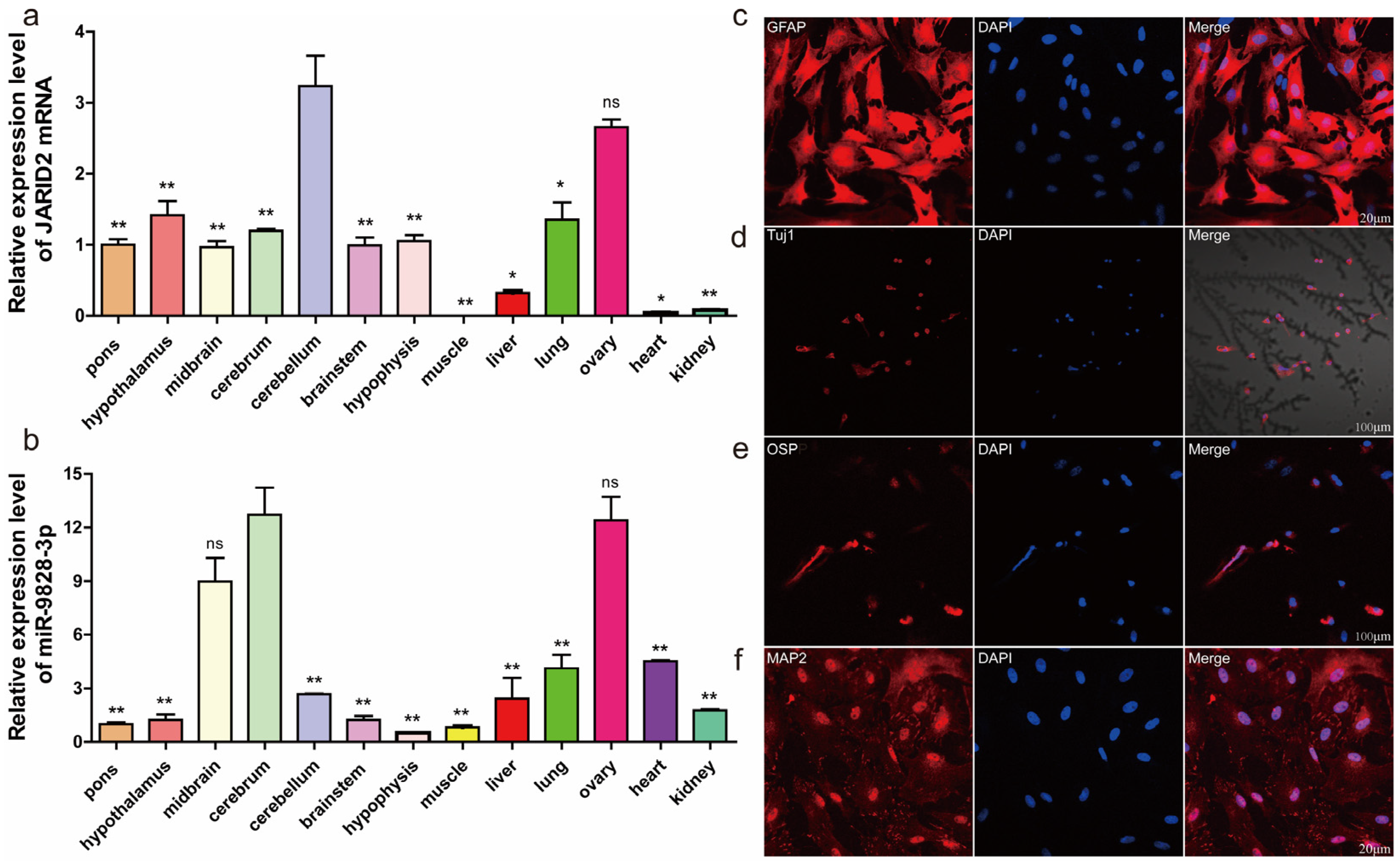
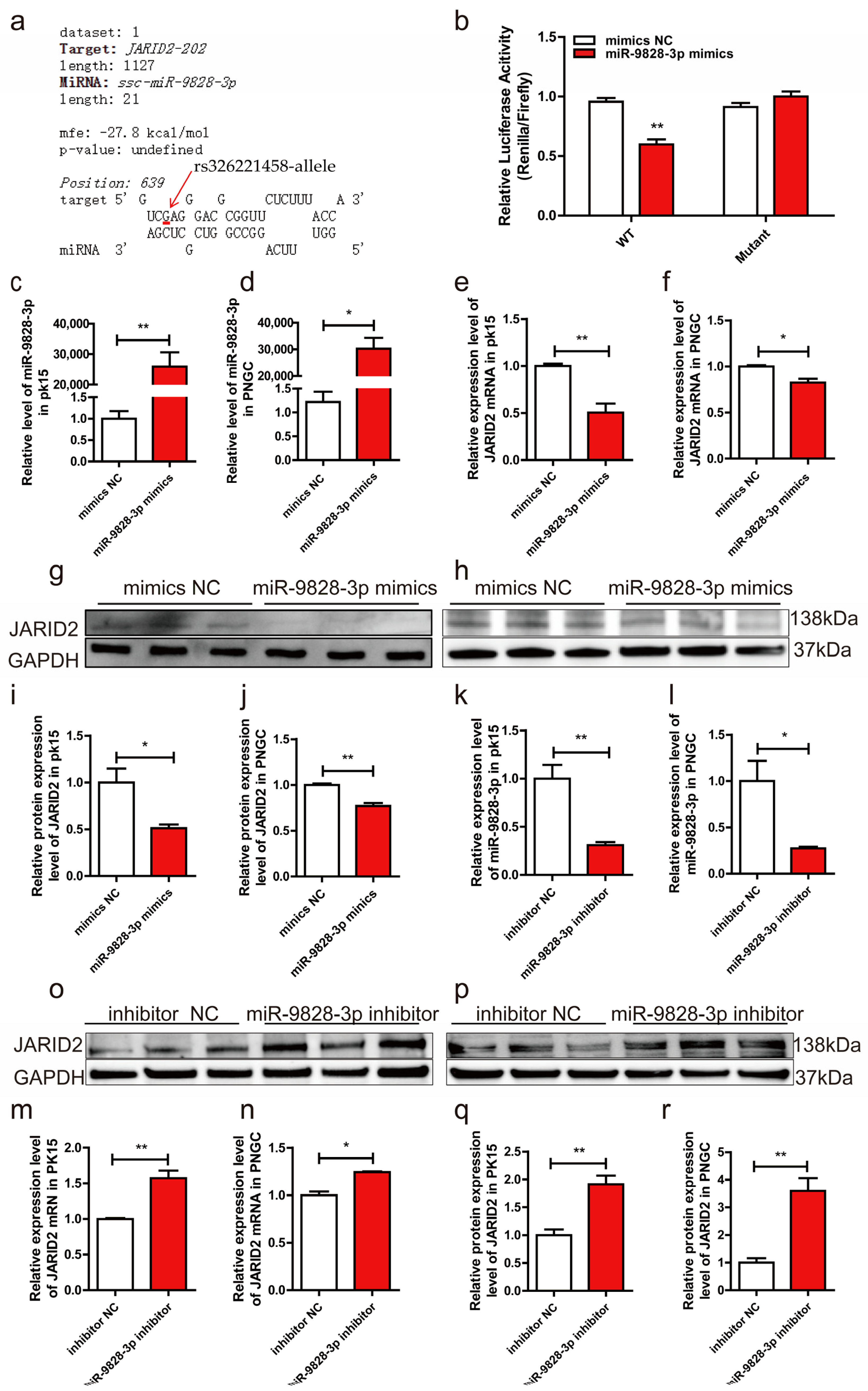
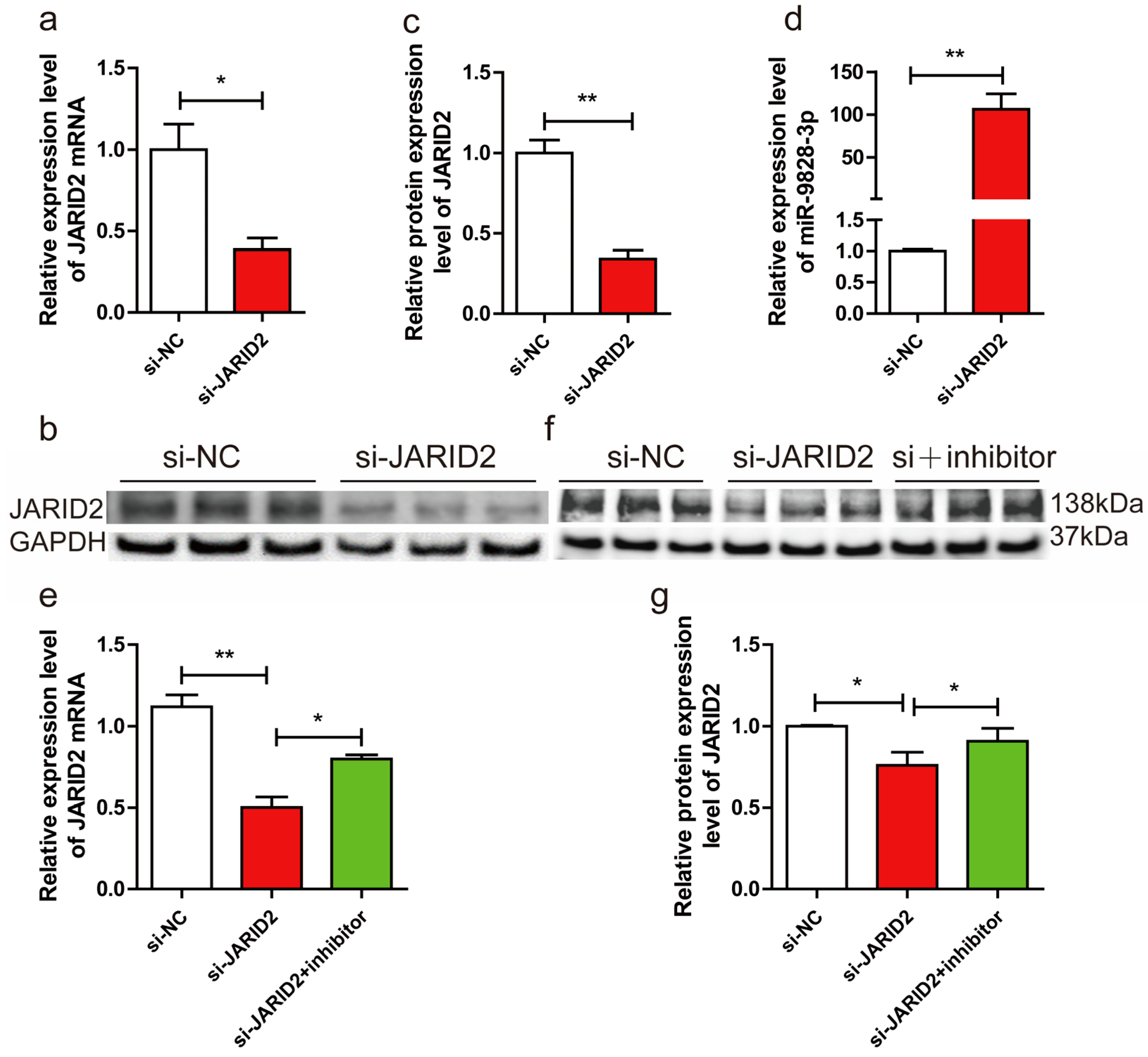
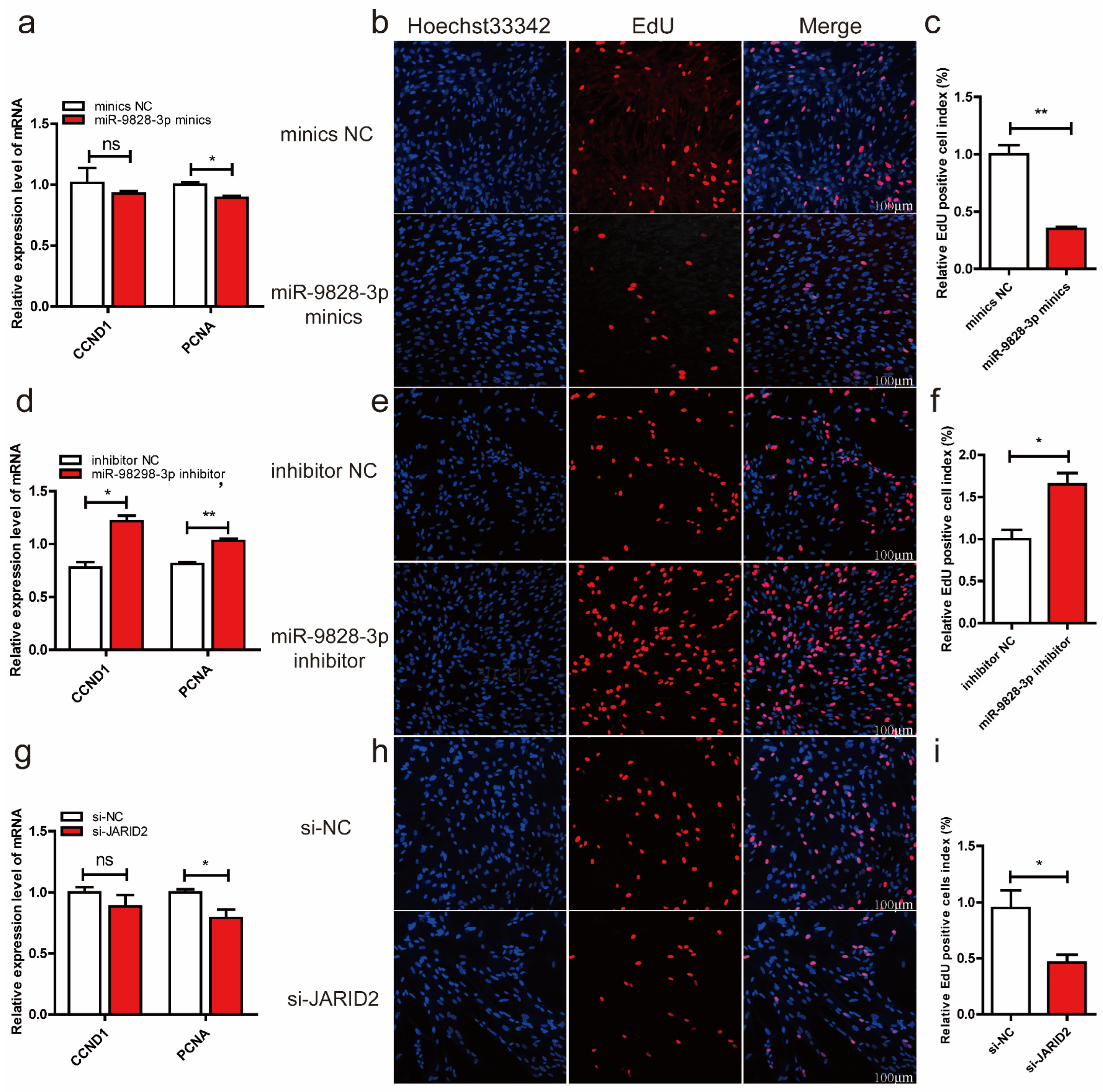
Disclaimer/Publisher’s Note: The statements, opinions and data contained in all publications are solely those of the individual author(s) and contributor(s) and not of MDPI and/or the editor(s). MDPI and/or the editor(s) disclaim responsibility for any injury to people or property resulting from any ideas, methods, instructions or products referred to in the content. |
© 2023 by the authors. Licensee MDPI, Basel, Switzerland. This article is an open access article distributed under the terms and conditions of the Creative Commons Attribution (CC BY) license (https://creativecommons.org/licenses/by/4.0/).
Share and Cite
Yang, H.; Zhang, C.; Chao, X.; Zhao, J.; Liu, M.; Chen, J.; Liu, S.; Wang, T.; Muhammad, A.; Schinckel, A.P.; et al. A Functional Single Nucleotide Polymorphism in the 3′ Untranslated Region of the Porcine JARID2 Gene Is Associated with Aggressive Behavior of Weaned Pigs after Mixing. Int. J. Mol. Sci. 2024, 25, 27. https://doi.org/10.3390/ijms25010027
Yang H, Zhang C, Chao X, Zhao J, Liu M, Chen J, Liu S, Wang T, Muhammad A, Schinckel AP, et al. A Functional Single Nucleotide Polymorphism in the 3′ Untranslated Region of the Porcine JARID2 Gene Is Associated with Aggressive Behavior of Weaned Pigs after Mixing. International Journal of Molecular Sciences. 2024; 25(1):27. https://doi.org/10.3390/ijms25010027
Chicago/Turabian StyleYang, Huan, Chunlei Zhang, Xiaohuan Chao, Jing Zhao, Mingzheng Liu, Jiahao Chen, Shuhan Liu, Tianshuo Wang, Asim Muhammad, Allan P. Schinckel, and et al. 2024. "A Functional Single Nucleotide Polymorphism in the 3′ Untranslated Region of the Porcine JARID2 Gene Is Associated with Aggressive Behavior of Weaned Pigs after Mixing" International Journal of Molecular Sciences 25, no. 1: 27. https://doi.org/10.3390/ijms25010027





